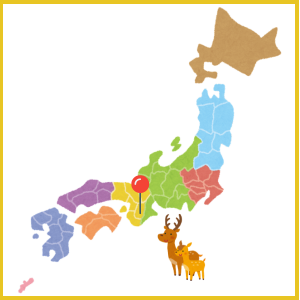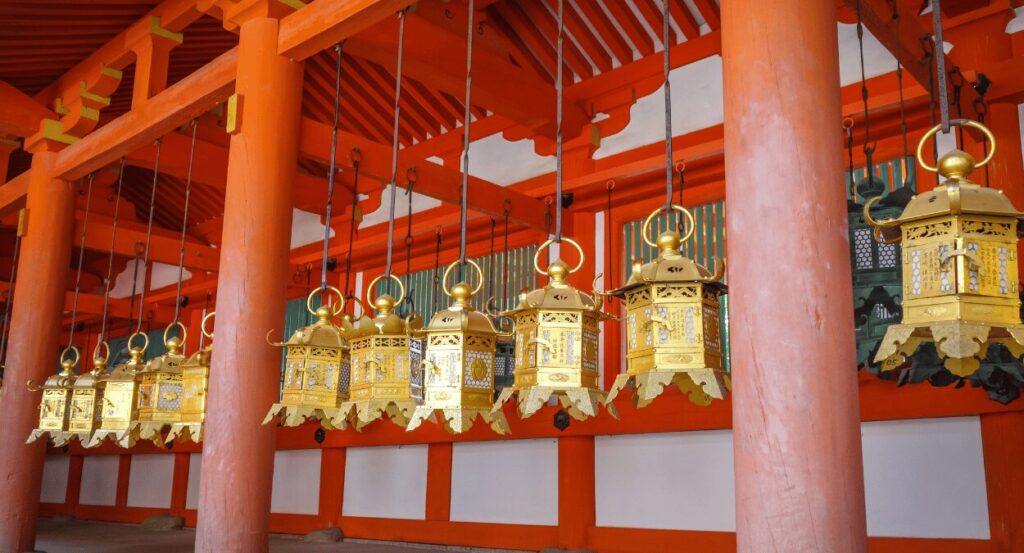Nara is a must-see destination that beautifully blends history and nature. From the inspiring Todai-Ji Temple to the tranquil beauty of Nara Park, these five must-visit spots will make your journey unforgettable.
Nara is just a short trip from Osaka or Kyoto, making it a great option for a day visit. If you’re exploring the Kansai region, be sure to check it out!
Introduction to Nara
Nara is located in the Kansai region of Japan, which is in the western part of the main island. It is known for its rich history and cultural heritage.

From the Shin-Osaka area, it takes about 45 minutes to reach Nara by train. You can take the JR Yamatoji Line or the Kintetsu Nara Line, both provide direct access.
Nara, was Japan’s first permanent capital, established in 710 AD during the Nara Period, a time when the country began to consolidate its power and culture. It remained the capital until 784 AD.
1. Todai-ji Temple: Marvel at the Great Buddha

Todai-ji (toe-dye-gee) Temple, located in Nara, Japan, is one of the most significant and historic Buddhist temples in the country. It is renowned for its grand architecture and spiritual importance, being a UNESCO World Heritage Site.
Check Todai-ji’s official website for hours and entrance fee.
Great Buddha Hall (大仏殿 Daibutsuden)
- The Great Buddha Hall is the centerpiece of Todai-ji and is recognized as one of the largest wooden buildings in the world.
- Originally built in 752 AD, the hall contains a massive statue of Vairocana Buddha (known as Daibutsu), which is 15 meters (49 feet) tall.
- The hall itself has been rebuilt several times, with the current structure dating back to 1709. It showcases stunning wooden beams and intricate details that reflect traditional Japanese architectural style.
Nandaimon Gate (南大門 Great South Gate)

- This impressive gate serves as the main entrance to the temple complex and is guarded by two towering “Ni-ō (Two Kings)”.
- The gate is a masterpiece of Japanese architecture, with its massive wooden structure and striking sculptures that protect the temple from evil spirits. Both statues measure just over 8.4 meters (27.5 feet) in height.
Crawling Through the Pillar Hole

If you’re visiting Todai-ji for the first time, you might come across a fascinating activity that many tourists and locals participate in: crawling through the hole in the Great Buddha Hall’s pillar. This seemingly simple act holds deeper significance and offers a unique experience for visitors.
The hole is found in the southeast pillar of the Great Buddha Hall (Daibutsuden). The pillar itself is a large wooden structure that supports the impressive hall housing the Great Buddha statue.
The hole measures about 0.9 meters (approximately 3 feet) in height and width, just the right size for children and adventurous adults. It is believed that crawling through this hole brings good health, and the fulfillment of your wishes. Traditionally, it symbolizes the passage from ignorance to wisdom, allowing visitors to reflect on their spiritual journey.
2. Kofuku-ji Temple: Explore Historic Architecture

Kofuku-ji Temple, established in 669 AD by the powerful Fujiwara clan, this temple has deep roots in Japanese Buddhism and has played a significant role in the region’s spiritual development.
The temple has undergone several renovations and restorations over the centuries, reflecting the various architectural styles of different eras. It was once one of the most important temples in Japan and is now a UNESCO World Heritage Site, part of the “Historic Monuments of Ancient Nara.”
- Five-Story Pagoda: The most recognizable feature of Kofuku-ji is its stunning five-story pagoda, which stands at 50 meters tall, making it one of the tallest pagodas in Japan.
- Great Buddha Hall (Tokondo): This hall houses a large statue of the Buddha, showcasing exquisite craftsmanship.
- National Treasure Museum: The temple also features a museum that exhibits various cultural treasures, including ancient Buddhist artifacts and art pieces that tell the story of Kofuku-ji and its significance throughout Japanese history.
As of October 2024, the Five-story Pagoda is under construction.
3. Kasuga-taisha Shrine: Experience Traditional Shinto Culture

Kasuga-taisha, a prominent Shinto shrine in Nara, is renowned for its stunning architecture and deep spiritual significance. Founded in 768 AD by the Fujiwara clan, it was originally dedicated to the deity of protection for the city of Nara and the Fujiwara family.
The shrine complex has been designated as a UNESCO World Heritage Site, recognizing its cultural importance.
- Lanterns: One of the most striking features of Kasuga-taisha is its thousands of stone and bronze lanterns. These lanterns line the paths leading to the shrine and are lit during the famous Lantern Festivals.
- Sacred Deer: The deer around the shrine are considered sacred and are believed to be messengers of the gods.
- Main Shrine (Honden): The main building, Honden, features bright vermilion columns, white walls, and roofs made of hinoki cypress bark, creating a striking contrast with the surrounding lush greenery. T, white walls, and roofs made of hinoki cypress bark, creating a striking contrast with the surrounding lush greenery.
4. Nara Park: Interact with Friendly Deer

Nara Park, located in the heart of Nara, is a beautiful and expansive public park that serves as a central hub for visitors exploring the city’s historic sites. Established in 1880, it covers over 660 hectares and is home to some of Japan’s most iconic landmarks, including Todai-ji Temple and Kasuga-taisha Shrine.
One of the park’s most charming features is the hundreds of free-roaming deer that wander the grounds. These deer are considered sacred and are friendly, often approaching visitors for food. You can purchase special crackers called “shika senbei” to feed them.
Deer are said to be messengers of the gods
The reason there are many deer in Nara is that they are regarded as sacred in Nara Park. Deer have long been considered messengers of the gods, particularly associated with Kasuga-taisha Shrine. The connection between deer and the divine can be traced back to various myths and legends. People take great care of the deer and feed them, which has naturally led to an increase in their population.
Mother deer with fawns can sometimes be aggressive, so be cautious.
5. Naramachi: Stroll Through Historic Streets

Naramachi, the old town of Nara, is one of the few places in Japan that has preserved the traditional lifestyle of its people, remaining largely untouched by the devastation of World War II, similar to Kyoto and Kanazawa.
- Traditional Townhouses (Machiya): The streets of Naramachi are lined with beautifully preserved machiya, or wooden townhouses. Many of these buildings have been converted into shops, cafes, and galleries.
- Local Cuisine: Naramachi is home to several eateries where visitors can savor local delicacies, such as kakinoha-zushi (sushi wrapped in persimmon leaves) and mochi. These culinary experiences allow you to taste the flavors of Nara.
- Art and Craft Shops: The district is known for its artisan shops selling traditional crafts, including pottery, textiles, and woodworking.
Nakatanidou: Famous Mochi shop

If you’re exploring Naramachi, make sure to stop by Nakatanidou, a renowned mochi shop famous for its “high-speed mochi pounding.” This traditional Japanese confectionery shop is celebrated for its delightful, freshly made mochi, which is pounded to perfection right before your eyes.
Watching the skilled artisans in action is truly a sight to behold; their rhythmic pounding is both mesmerizing and impressive. You can taste various types of mochi filled with sweet red bean paste and other delicious fillings, making for a perfect snack or souvenir.
Conclusion
Nara offers a unique blend of history, spirituality, and natural beauty that captivates every visitor. From the awe-inspiring Great Buddha at Todai-ji to the sacred deer wandering through Nara Park, each site tells a story that connects you to Japan’s rich heritage. Nara is a destination that leaves a lasting impression. Don’t miss the opportunity to experience this enchanting city for yourself.

